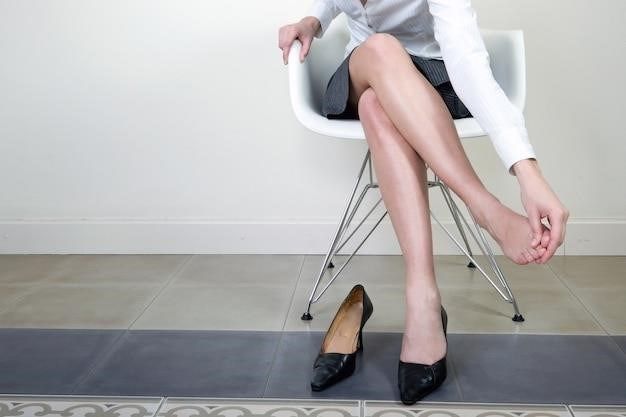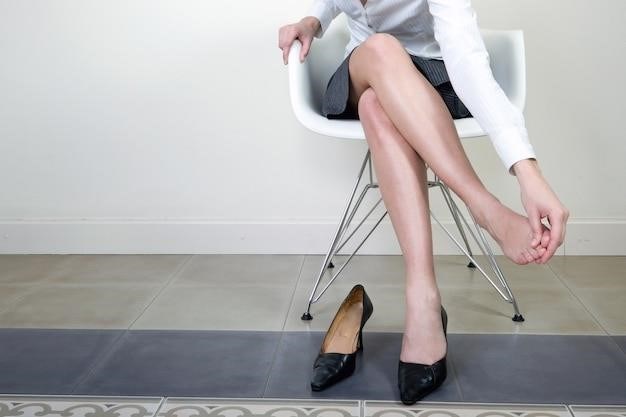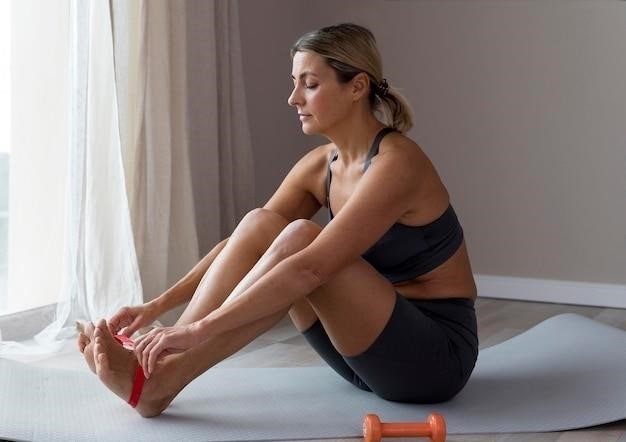Bunion Exercises⁚ A Guide to Relief
Bunions are a common foot condition that can cause pain‚ discomfort‚ and difficulty walking․ They are bony protrusions that appear at the base of the big toe joint‚ often caused by wearing shoes that are too narrow or pointed․ While there is no cure for bunions‚ there are many exercises that can help relieve pain and improve mobility․ This guide provides a comprehensive overview of bunion exercises‚ their benefits‚ and when to seek medical attention․
Understanding Bunions
A bunion is a bony bump that develops on the joint at the base of your big toe․ It occurs when the big toe joint is pushed outward‚ causing the bone to stick out․ This condition is often accompanied by inflammation and pain‚ making it difficult to walk or wear certain types of shoes․ The big toe may also bend inward toward the other toes‚ creating a condition known as hallux valgus․ While bunions can affect anyone‚ they are more common in women‚ particularly those who wear high heels or tight-fitting shoes․
Bunions can be caused by a combination of factors‚ including genetics‚ foot structure‚ and lifestyle choices․ Some people are simply more prone to developing bunions due to their family history or the shape of their feet․ Wearing shoes that are too narrow or pointed can also put pressure on the big toe joint‚ contributing to the development of bunions․ Additionally‚ certain medical conditions‚ such as rheumatoid arthritis‚ can increase the risk of developing bunions․
Bunions are not always painful‚ and some people may not experience any symptoms at all․ However‚ for those who do experience pain‚ it can range from mild to severe․ The pain may be worse when wearing shoes‚ standing for long periods‚ or participating in physical activity․ In addition to pain‚ bunions can cause other symptoms‚ such as redness‚ swelling‚ and tenderness around the big toe joint․ If left untreated‚ bunions can worsen over time‚ leading to more severe pain and difficulty walking․
Causes of Bunions
Bunions are a common foot condition that develops when the big toe joint is pushed outward‚ causing the bone to stick out․ While there is no single cause‚ a combination of factors can contribute to the development of bunions‚ including⁚
- Genetics⁚ Some people are simply more prone to developing bunions due to their family history or the shape of their feet․ If your parents or grandparents had bunions‚ you are more likely to develop them as well․
- Foot Structure⁚ Certain foot structures‚ such as flat feet or high arches‚ can increase the risk of developing bunions․ These foot types can put extra stress on the big toe joint‚ making it more susceptible to displacement․
- Shoes⁚ Wearing shoes that are too narrow or pointed can put pressure on the big toe joint‚ forcing it to push against the other toes․ High heels‚ in particular‚ can contribute to the development of bunions․
- Medical Conditions⁚ Certain medical conditions‚ such as rheumatoid arthritis‚ can increase the risk of developing bunions․ These conditions can cause inflammation and joint damage‚ which can lead to bunion formation․
- Age⁚ Bunions are more common in older adults as the ligaments and tendons in the feet can weaken with age‚ making them more susceptible to displacement․
- Injuries⁚ Injuries to the foot‚ such as a sprain or fracture‚ can also contribute to the development of bunions․ These injuries can damage the ligaments and tendons that support the big toe joint‚ leading to instability and misalignment․
It is important to note that not everyone who has these risk factors will develop bunions․ However‚ if you have any of these factors‚ it is important to be aware of the potential for developing bunions and take steps to prevent them‚ such as wearing comfortable shoes with a wide toe box․
Bunion Exercises for Relief
While bunions can be a painful and frustrating condition‚ there are several exercises that can help alleviate discomfort and improve mobility․ These exercises focus on strengthening the muscles surrounding the big toe joint‚ improving flexibility‚ and promoting proper alignment․ Here are some examples⁚
Toe Stretches
Place your foot flat on the floor and try to spread all your toes outwards․ This exercise helps stretch the muscles and tendons surrounding the big toe‚ improving flexibility and reducing stiffness․
Toe Grabs
Sit with your feet flat on the floor․ Use your fingers to gently pull your big toe upwards‚ holding for a few seconds․ Repeat this movement several times․ This exercise strengthens the muscles that control the big toe‚ improving its stability and reducing strain on the joint․
Ball Roll Exercise
Place a tennis or lacrosse ball on the floor and put your foot on top․ Roll your foot back and forth over the ball‚ focusing on the area around the bunion․ This exercise helps to massage the tissues surrounding the bunion‚ reducing pain and inflammation․
It is important to note that these exercises are not a cure for bunions․ They can help manage symptoms and improve mobility‚ but they will not eliminate the bunion itself․ If you experience any pain or discomfort during these exercises‚ stop immediately and consult with your doctor or a physical therapist․

Toe Stretches
Toe stretches are a simple yet effective way to improve flexibility and reduce stiffness in the big toe joint‚ which can contribute to bunion pain․ These exercises help lengthen the muscles and tendons surrounding the big toe‚ promoting proper alignment and reducing strain on the joint․ Here are some examples⁚
- Flat Foot Stretch⁚ Place your foot flat on the floor‚ ensuring your heel is firmly grounded․ Then‚ focus on spreading all your toes outwards as far as possible․ This stretch helps to open up the space between your toes and encourages proper alignment․ Hold this position for 30 seconds‚ repeating three times․
- Towel Stretch⁚ Sit on the floor with your legs extended․ Place a towel around the toes of your affected foot‚ holding the ends of the towel in your hands․ Gently pull the towel towards you‚ stretching your toes and the muscles surrounding the big toe joint․ Hold this stretch for 30 seconds‚ repeating three times․
- Marble Pick Up⁚ Scatter a few marbles on the floor․ Sit with your feet flat and try to pick up the marbles with your toes‚ one at a time․ This exercise encourages the use of your toe muscles and helps to improve their strength and flexibility․ Repeat this exercise for 5-10 minutes․
Remember to listen to your body and stop if you experience any pain or discomfort․ It is always recommended to consult with a physical therapist or podiatrist to tailor exercises to your specific needs and ensure proper technique․
Toe Grabs
Toe grabs are another effective set of exercises that target the muscles surrounding the big toe joint‚ enhancing strength and flexibility․ These exercises can help improve the range of motion in the big toe and reduce pain associated with bunions․ Here are some examples⁚
- Toe Curling⁚ While sitting or standing‚ curl your toes under as if you are trying to grab the floor․ Hold this position for a few seconds‚ then release․ Repeat this exercise 10-15 times․ This exercise strengthens the muscles responsible for flexing your toes and helps improve their grip strength․
- Toe Extension⁚ Following the toe curling exercise‚ extend your toes as far as possible‚ pointing them upwards․ Hold this position for a few seconds‚ then release․ Repeat this exercise 10-15 times․ This exercise helps to stretch the muscles responsible for extending your toes‚ improving their flexibility and range of motion․
- Toe Spread⁚ While sitting or standing‚ spread your toes apart as much as possible‚ trying to touch the floor with the outer edges of your feet․ Hold this position for a few seconds‚ then release․ Repeat this exercise 10-15 times․ This exercise strengthens the muscles responsible for spreading your toes and helps to improve their strength and flexibility․
Remember to listen to your body and stop if you experience any pain or discomfort․ It is always recommended to consult with a physical therapist or podiatrist to tailor exercises to your specific needs and ensure proper technique․
Ball Roll Exercise
The ball roll exercise is a simple yet effective way to target the muscles in your feet and improve flexibility․ This exercise involves using a tennis or lacrosse ball to massage and stretch the muscles in your feet‚ helping to relieve pain and improve mobility․ Here’s how to perform the ball roll exercise⁚
- Preparation⁚ Place a tennis or lacrosse ball on the floor․ Sit or stand comfortably with your feet flat on the floor․
- Rolling Motion⁚ Place your affected foot on top of the ball․ Slowly roll your foot back and forth over the ball‚ applying gentle pressure․ Focus on rolling the ball along the arch of your foot‚ the ball of your foot‚ and the area around your big toe joint․
- Duration⁚ Repeat this rolling motion for 3 to 5 minutes on each foot․ You can adjust the pressure and speed of the rolling motion based on your comfort level․
- Consistency⁚ Aim to perform this exercise at least twice a day for optimal results․ You can incorporate this exercise into your daily routine by doing it while watching TV or reading a book․
The ball roll exercise helps to improve blood circulation‚ reduce muscle tension‚ and increase flexibility in your feet․ It also helps to strengthen the muscles supporting your arches‚ which can help to prevent further foot problems․ Remember to consult with a physical therapist or podiatrist for personalized guidance and modifications based on your specific needs․
Benefits of Bunion Exercises
While bunion exercises cannot cure the underlying bone deformity‚ they offer significant benefits in managing the pain and discomfort associated with bunions․ These exercises work by strengthening the muscles surrounding the big toe joint‚ improving flexibility‚ and promoting better blood circulation․ By addressing these factors‚ bunion exercises can help alleviate symptoms and improve overall foot health․
One of the primary benefits of bunion exercises is pain reduction․ By strengthening the muscles that support the big toe joint‚ these exercises help to reduce pressure on the bunion‚ leading to decreased pain and inflammation․ Additionally‚ improved flexibility in the foot can help to alleviate pain caused by tight muscles or restricted joint movement․
Another notable benefit is improved mobility․ Bunions can restrict movement in the big toe‚ making it difficult to walk‚ run‚ or engage in other activities․ Bunion exercises help to improve the range of motion in the big toe joint‚ making it easier to move and participate in daily activities․ Furthermore‚ exercises can help prevent further deterioration of the bunion by strengthening the muscles that support the joint and promoting proper foot alignment․
Incorporating bunion exercises into your daily routine can contribute to a healthier and more comfortable lifestyle․ Remember to consult with a physical therapist or podiatrist for personalized guidance and modifications based on your specific needs․

Preventing Bunions
While bunions are often associated with genetic predisposition‚ several lifestyle choices and habits can significantly influence their development․ By adopting preventive measures‚ individuals can reduce their risk of developing bunions and maintain healthy foot health․
One of the most crucial preventive steps is wearing appropriate footwear․ Shoes that are too narrow‚ pointed‚ or high-heeled can put excessive pressure on the toes‚ forcing them to crowd together and increasing the risk of bunion formation․ Opting for comfortable shoes with a wide toe box and a low heel allows the toes to spread naturally and reduces pressure on the big toe joint․
Maintaining a healthy weight is another important factor in preventing bunions․ Excess weight puts additional stress on the feet‚ increasing the likelihood of developing bunions․ By maintaining a healthy weight through a balanced diet and regular exercise‚ you can reduce the strain on your feet and minimize the risk of bunion development․
Regular foot exercises can also play a crucial role in preventing bunions․ Strengthening the muscles in your feet and ankles helps to support the arches and improve foot alignment‚ reducing the risk of bunion formation․ Simple exercises like toe curls‚ toe stretches‚ and calf raises can effectively strengthen the muscles and contribute to overall foot health․
By incorporating these preventive measures into your lifestyle‚ you can significantly reduce your risk of developing bunions and enjoy healthy‚ comfortable feet;
When to See a Doctor
While bunion exercises can offer relief and improve mobility‚ it is crucial to recognize when seeking professional medical advice is necessary․ If your bunion symptoms persist or worsen despite home remedies and exercises‚ consulting a podiatrist or orthopedic surgeon is recommended․
Here are some signs that indicate the need for medical attention⁚
- Intense pain that significantly hinders daily activities․
- Redness‚ swelling‚ or inflammation around the bunion joint․
- Difficulty walking or putting weight on the affected foot․
- Numbness or tingling sensations in the toes․
- Deformity of the big toe that prevents you from wearing comfortable shoes․
- Open sores or wounds near the bunion joint․
A podiatrist can assess your condition‚ diagnose the cause of your bunion‚ and recommend appropriate treatment options․ They may suggest custom orthotics‚ medications‚ or even surgery‚ depending on the severity of your condition․ Early diagnosis and treatment can prevent further complications and improve your long-term foot health․
Remember‚ if you experience any concerning symptoms‚ don’t hesitate to seek professional medical advice․ Prompt intervention can alleviate pain‚ restore mobility‚ and ensure optimal foot health․
